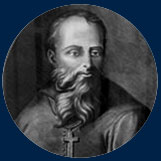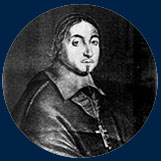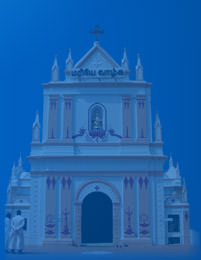
- The Pondicherry Mission before 1700 A.D
- The Presence of the MEP
- Mgr.Pierre Brigot (1776-1791)
- Mgr Champanois (1786-1810)
- Mgr.Hebert (1810-1836)
- Mgr.Bonnand (1836-1846)
- Mgr.Godelle (1861-1867)
- Bishop Laouenan (1868-1892)
- Archbishop Gandy (1892 - 1909)
- Archbishop Morel (1909-1930)
- Archbishop A.S.Colas (1930-1955)
- Archbishop R.Ambrose (1955-1973)
- Archbishop V.S.Selvanather (1973-1992)
- Archbishop Michael Augustine (1992-2004)
- Archbishop A. Anandarayar (2004-2021)
- The chronological Tree of our Former Prelates
- Contribution of the Archdiocese to Holy Mother the Church
Patron: Our Lady of the Immaculate Conception
Area: 11,348 Sq. Kms.
Catholics: 3,79,984
Language: Tamil, French, English and Malayalam.
Suffragan Dioceses: Dharmapuri, Kumbakonam, Salem and Thanjavur
 THE PONDICHERRY MISSION BEFORE AD 1700
THE PONDICHERRY MISSION BEFORE AD 1700 
The great ancestor of the Archdiocese of Pondicherry and Cuddalore is the Carnatic Mission, which was started around the year 1700. This Carnatic Mission was also known as the “Missions of the Coromandal Coast” or also as the “Malabar Mission”.
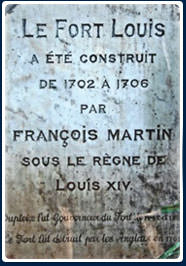
THE COMING OF THE CAPUCHINS
The French Capuchins came to Pondicherry in the year 1632, but remained only for a short time. Later in 1673, Mr.Bellanger de Lespinay a French Naval Officer, invited three Capuchins from Madras to take care of the sailors in Pondicherry for some time.
It was only in 1674 that at the invitation of Mr.Francois Martin the French Capuchins from Madras came to Pondicherry and settled there permanently to look after the chapel in the small French Fort, and also the spiritual needs of the French, Portuguese and Eurasian settlers there.
Soon some Indian Christians joined the French settlement. For their benefit, the Capuchins built a chapel in the southern part of the fort and dedicated it to St.Peter. However, this church began to be called the church of St.Lazarus after the name of a generous Indian benefactor, Mr.Lazare de Motha. Soon it began to be called as the “Church of Malabars” and it served as a parish church till the year 1729.
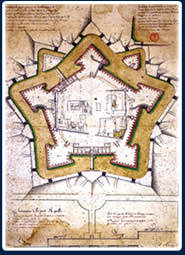
The Armenian Presence
In 1690 an Armenian Bishop, Msgr. D’Adda, built the church of Our Lady of Conception at Ariankuppam, near Pondicherry, for the spiritual needs of mostly Armenian merchants settled there. When this chapel was handed over to the Jesuits, the Bishop retired near the present “Our Lady of Angels’ Church” in the street still named “rue d’ Eveche’” (Bishop’s House Street) and died there. In 1714, the Jesuits built a new church in the place where stood the Armenian chapel and dedicated it to “Our Lady of Good Health” and developed into a major pilgrim centre for the Pondicherry region for centuries.
Arrival of the Jesuits
Between 1640 and 1647 AD many Christians fled from Trichirappalli and Thanjavur areas due to wars, famine and persecutions and took refuge in the Gingee Kingdom. We notice from 1660 to 1700, Fr.Freire, Fr.John de Britto (who became later martyr and saint) and Fr.Laynez (who became later Bishop of Mylapore) visiting these Christian settlements regularly.
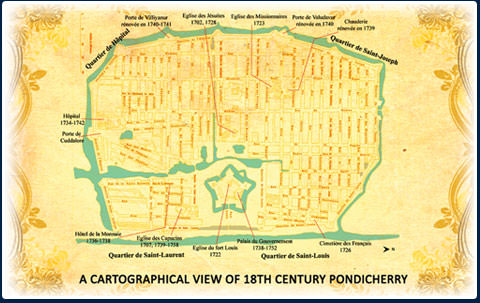
In 1695 the French King Louis XIV entrusted the work of evangelization of the French territories in India to the Jesuits. By the intervention of Mr.Francois Martin, it was decided that the Capuchins would take care of the Europeans and the Eurasians, while the Jesuits would look after the Indians of the French territories. The Jesuits who could not go back to Thailand decided to stay on and develop the North of Madurai Mission, a new Mission named by them as Carnatic Mission.
 The Presence of the “Prètres de la Societé de Missions Etrangères de Paris” (MEP)
The Presence of the “Prètres de la Societé de Missions Etrangères de Paris” (MEP) 
- Mgr. Francois Pallu
- Mgr. Lambert De La Motte
- Mgr. Ignace Gotolendi
The Founders of the Society of Paris, Mgr.Pallu, Msgr.de La Motte – Lambert and Mgr.Gotolendi had passed through India.
The Priests of the Society of Missions Etrangères de Paris (MEP in short) took shelter in India, when expelled from Siam by the revolution of 1687. They first set up a Procure at Chandernagore in Bengal but later shifted it to Pondicherry. Two members of the French Foreign Missions Society Father de Lionne and Father de la Vigne came to Pondicherry. Fr.de Lionne set up the Procure and appointed Father de la Vigne as its first Procurator in 1688.
Fr.de la Vigne who was also expelled by the Dutch in 1693 from Pondicherry along with the French Jesuits suffered very much for spreading of the Gospels. When Pondicherry was restored to the French, he returned to Pondicherry in 1699 and he started the construction of a building in a piece of land donated by a Christian lady by name Maria Dias – the land where to-day stands the Clock Tower of the Big Bazaar. It was completed by Fr.Tessier de Queralay who arrived at Pondicherry in 1699.
Procure de la Mission
In 1730 on a piece of land donated by one “Pootchiammal” at Big Bazaar Street, they erected the “Church of the Foreign Missions” dedicated to the Presentation of the Blessed Virgin Mother. This land was adjacent to the one given by Madame Maria Dias in 1699. Mr.Ananda Ranga Pillai speaks of this church of the Missionaries (MEP) in his well-known diary. With their church and Procure in Pondicherry, the MEP Fathers helped the Capuchins and the Jesuits with great enthusiasm in mission work.
College General
It was established in Siam in 1666 and was destroyed by the Burmese invasion in 1767. Hence, the MEP Fathers decided to shift it to a safer territory, namely Pondicherry. This Major Seminary established in 1771 was meant to prepare and form native priests for all their missions in the far-eastern countries. The Directors of the MEP Society bought a piece of land at Virampattinam, near Pondicherry. In 1775 Pope Pius VI approved the College General of Virampattinam and placed it under the special care of the Holy See. The first Rector was Fr.Pigneau de Behaine, who later became the Coadjutor Bishop of Cochinchina.

Carnatic Mission Outside the French Territories of Pondicherry (1700-1777)
In 1703 the Carnatic mission consisted of two linguistic parts: the Tamil Part and the Telugu Part – outside the French territories: A/ The Tamil Part extended between the rivers of Pennaiyar in the south and Palar in the north; from the coast beyond the Gingee and Vellore Kingdoms. B/ The Telugu Part extended from the river Palar to Masulipatnam and beyond the river Krishna. Political instability and the military presence forced many Christians to abandon their settlements and take refuge elsewhere. It was in such a difficult situation that the Society of “Missions Etrangères de Paris” (MEP) accepted to take charge of the Missions in the South of India, fully aware of the challenges facing them.
The MEP Society at the Helm of the Mission Since 1776
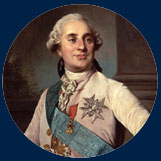 King Louis XVI
King Louis XVI
King Louis XVI of France, by a decree dated March 1776, declared that the Malabar Mission would be run by the “Body of the Association of the Foreign Missions (MEP). Pope Pius VI approved this appointment.
In July 1776 Mgr.Brigot was chosen as Superior of the Malabar (Carnatic) Mission and on 30th September 1776 he was given the title of “Superior He was given all the faculties of a Vicar Apostolic except the name.
 MGR. PIERRE BRIGOT (1776-1791)
MGR. PIERRE BRIGOT (1776-1791) 
The most important aim of the MEP – namely the formation of the local clergy – was not lost sight of by Mgr.Brigot. He wanted to send some seminarians to the seminary already in 1777. But since the College General of the MEP was having students of Annamese and Chinese origin, the caste ridden Indian students did not want to live with those students, whom they considered as untouchables. Taking into account the Indian mentality, Mgr.Brigot decided to start his own seminary. In 1778, he entrusted this work to Fr.Busson with a small house at Oulgaret as a seminary.
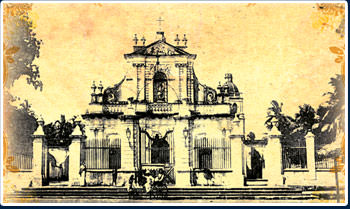 Our Lady of Immaculate Conception Cathedral
Our Lady of Immaculate Conception Cathedral
Thirty-six years a Bishop and that at a time extremely rough and full of difficulties and trials, Mgr.Brigot had the honour and the merit of presiding over the birth of Pondicherry Mission and of laying down firm foundations for the future generations to build and grow to the eternal glory of God.
The construction of the Cathedral, started by the Jesuits in 1770 on the foundation of the church of 1736, was completed only in 1791. Mgr.Champenois dedicated it on the 07th November 1791 under the same title of "Immaculate Conception".
 MGR.CHAMPENOIS (1786-1810)
MGR.CHAMPENOIS (1786-1810) 
Mgr.Champenois, appointed by Rome was ordained Bishop in 1786 at Pondicherry. Mgr.Brigot handed over all his responsibilities to his Co-adjutor and after a period of 5 years in prayer and suffering he passed away in 1791. It was about this time that Mgr.Champenois built a new building for seminary near the Cathedral and completed it in 1790.
In 1805 Mgr.Champenois, 71 years old and tired who wanted to retire asked for a Co-adjutor. Mgr.Hebert was to be ordained on 1st of May 1810. But Mgr.Champenois fell down and was indisposed. The ordination was postponed till his death.
During his time the Mission had to face severe persecutions of Christians by Tippu Sultan in India and the French Revolution in France.
 MGR.HEBERT (1810-1836)
MGR.HEBERT (1810-1836) 
Mgr.Hebert was elected as Co-adjutor already in 1806 with the title of Bishop of Halicarnasse. Due to his illness and at his own reluctance to became bishop, his ordination was delayed. When Mgr.Champenois died in 1810, he was ordained Bishop on 2nd March 1811 from the hands of a Carmelite Bishop of Syrian Rite at Verapoly. For this, Mgr.Hebert, a sickly man had to cover 1000kms traveling on Bullock cart for his consecration.
During the period of Mgr.Hebert, cholera and famine had their toll of woes. In 1829 there was a severe attack of cholera. And due to failure of monsoons, a general famine followed. Mgr.Hebert went to the extent of having the sacred vessels melted and sold out to give relief to the poor.
In 1827, Viscount Desbassyns invited to Pondicherry the Sisters of St.Joseph of Cluny. On 13th September 1836 Mgr.Bonnand, who was on his pastoral tour, received a letter from Mgr.Hebert, asking him to return to Pondicherry immediately. On his arrival he found Mgr.Hebert unconscious and dying. Mgr.Hebert died on the 3rd of October 1836, without ever using the title of Apostolic Vicar conferred on him. It was due to the insistence of Mgr.Hebert that Rome decided to create several Apostolic Vicariates. In 1832 the Vicariate of Madras was created; in 1834 the vicariates of Calcutta, Sindhana and Ceylon; on the 8th of July 1835, the vicariate of the Coromandal coast with Mgr.Hebert holding the title was created. At the request of Mgr.Hebert the Madurai Mission was detached from the Malabar Mission on the 23rd of December 1836.
 Mgr.Bonnand (1836-1846)
Mgr.Bonnand (1836-1846) 
Mgr.Hebert, due to his ill-health, wanted a successor. After much struggle he got the consent of Mgr.Bonnand to accept the bishoporic on 8th November 1833. Mgr.Bonnand was ordained under the title of Bishop of Drusipare at Oulgaret, near Pondicherry.
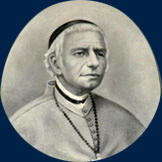 Mgr.Bonnand
Mgr.Bonnand
Press Apostolate:
Mgr.Bonnand encouraged his priests to enter into the press media. Mgr.Bonnand himself published a "small" catechism book in 1837 and another "big" catechism book in 1841. Fr.Dupuis published two works in Tamil against Protestantism. Fr.Charbonnaux issued a booklet in 1840 to refute heresy and another one specially meant for catechists. Fr.Bigot-Beauclan wrote a Treatise on Religion. Fr.Bardonil began a Telugu Dictionary.
Printing all these books in different presses drained the resources of the mission. Therefore Mgr.Bonnand took a bold decision to set up a press in the Mission itself. In 1840 he obtained permission from the government and permission from Rome in 1841. With the help of the French Administration and with the Tamil types and a printing press bought from the ex-gazetteer of Pondicherry, the Mission Press was solemnly inaugurated. The first printer appointed was Fr.Dupuis, who undertook at once the writing of a Tamil-English-Latin- French Dictionary. He also brought out the famous Tamil-French Dictionary of the Mission with the collaboration of Fr.Mousset. It was one of the best of its kind then and still in use today. Within a period of four years hundreds of books were published.
EDUCATION
The education of the children and the youth had always been one of the greatest concerns of the MEP Fathers. The education of the girls and their training in useful skills were ably looked after by the sisters of St.Joseph of Cluny.
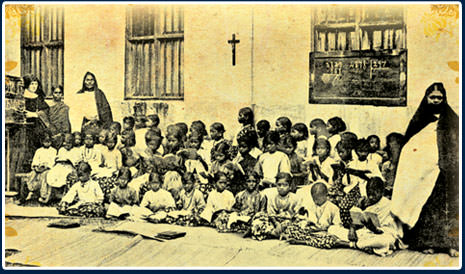 Sisters of St.Joseph of Cluny Teaching Tamil
Sisters of St.Joseph of Cluny Teaching Tamil
A serious training of catechists was considered as most important and urgent. Mgr.Bonnand himself as a priest started a small training school for the catechists at Punganur. Now as a Bishop he wanted it on a bigger scale. He needed money and personnel. He tried to recover the villages of Marakanam, Cheyur and Kadappakkam, which had been given by Madame Dupleix precisely for the formation and maintenance of catechists. But the British Government politely refused to oblige him.
The First Synod of Pondicherry:
In 1844, the First Synod of the Apostolic Vicariate of the Coromandal Coast took place in Pondicherry. It was decided to call for a general meeting under the form of a synod "to decide what would be the best for the good of the Missions". The main theme of the synod was defined: 'promotion of indigenous clergy, care of Christians and conversion'. On 8th January 1844 the opening ceremony of the Synod took place with the Mass of the Holy Spirit. The subjects treated in the synod were; training of the Indian clergy, education of boys and girls, the opening of a Minor Seminary, and a Major Seminary, printing of books, training of catechists, the care of the Christians, Sacraments, Commandments of God and the Church, the missionaries and evangelization.
The synod closed on 13th February. The deliberations of the Assembly were read out and each priest signed the document. The document was sent to Rome and Paris. Propaganda approved the text on 26th July 1845 with some minor alterations. On 23rd November 1845, the Sacred Congregation published a general instruction on the usefulness of the indigenous clergy, on catechists and on schools, obviously inspired by the document of the Pondicherry Synod.
Mgr. Bonnand made the proposals for the creation of new vicariates to Rome. The Supreme Pontiff on 16th March 1845 divided the Apostolic Vicariate of Coromandel Coast into three Missions Pondicherry, Mysore and Coimbatore.
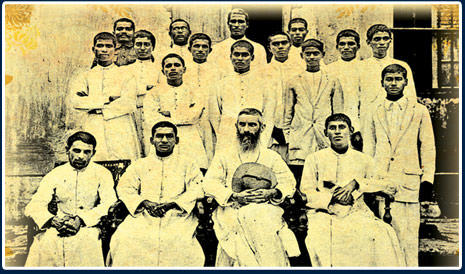 Group of Seminarians Pondicherry Provincial Seminary
Group of Seminarians Pondicherry Provincial Seminary
Mgr.Bonnand, Apostolic Vicar of Pondicherry (1846-1861)
The mission of Pondicherry in 1846 still had 83,000 Catholics out of a population of 8,000,000 inhabitants: The separated brethren were about 5000. To administer to this community, there were, besides the Apostolic Vicar, 24 missionaries and 5 Indian priests only.
Between 1847 and 1861, the MEP Society was able to send 43 missionaries to reinforce the "old ones". In contrast, between 1847 and 1861, only 9 Indians were ordained priests. A great help came to the missionaries in the form of Catechists. There were 102 Catechists and 164 "Kovil Pillais" or sacristans in 1846. Though untrained, they were of great use to the priests.
Reforms in the Seminaries
In 1848 the "Petit Seminaire" was opened on the model of a Minor Seminary in France, welcoming all young people, even non-seminarians for studies. A boarding home with 100 students was started. After settling the problem of the minor seminary, the good Bishop turned his attention to the problem of the Major Seminary. First, the two seminaries had to be separated. In 1850 a new building was constructed at the rear garden of the Mission and solemnly inaugurated on 18th September 1850.
Education of Girls
The training of a local clergy is the first aim of the Paris Foreign Missions Society. This supposes the training of young seminarians. Hence indirectly the education of the youth is linked to the primary end. These good youth could come from good families with good mothers. Hence the education of the girls was felt necessary. Since education of girls was a felt need, this could be done more easily and effectively by religious Sisters. Hence starting of local congregations was decided.
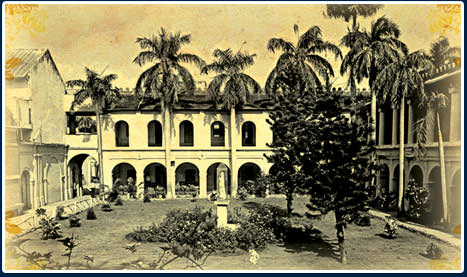 Petit Seminaire, Pondicherry
Petit Seminaire, Pondicherry
In 1844 Sisters of St.Joseph of Cluny were managing some schools and the Carmelite nuns some orphanages. Mgr.Bonnand thought of starting a Congregation of Indian Sisters.
Fr.Dupuis undertook the responsibility of starting a new Congregation. Two candidates presented themselves. With the help of a Carmelite novice as Superior, he had three ladies to start the Congregation. The new convent was officially opened on 16th October 1844. In 1846, a second house was opened in Karaikal, which also depended on a Carmelite for its Superior. Thus the present Congregation of the Holy and Immaculate Heart of Mary was launched.
The seminary crisis and the Revolution of 1848 in France arrested the progress to some extent. Homes adjacent to the Carmel in the "Rue Sainte Therese" were brought. Fr.Dupuis demolished the old buildings and put up the new building (to-day's Mother General's Home) investing all his personal money and even his ancestral wealth on it.
Gonzaga Sisters
Already by 1775, thanks to the vow of Fr.Courdoux, two orphanages were established by Fr.Ansaldo S.J. They were called "small convents" as they were under the care of the "great convent of Carmel". They were Bon Secours and the other St.Louis de Gonzague.
Fr.Lehodey and other priests started the process of converting the pious orphanage of St.Louis de Gonzague into a full-fledged teaching congregation. On 1st March 1853 the home was blessed and the school opened. In 1858 the Congregation of St.Louis de Gonzague and its novitiate were solemnly inaugurated.
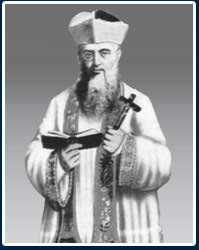 Fr.Dupuis
Fr.Dupuis
Education of Boys
The "College" for the French boys was taken over by the Governor, Mr.Desbassyns de Richemont. But it did not progress. The Governor requested Mgr.Bonnand to take over the College again. By a decree, dated 17th November 1846, approved by King Louis Philip the Royal College was handed over to the Home of the Foreign Missions with effect from 1st January 1847. In Karaikal a school was opened for the boys on 10th September 1855. In the British Territory of the Mission, many schools were opened. In 1861 there were 27 primary schools.
Election of a Co-adjutor
In April 1857 Fr.Metral was elected Apostolic Vicar of Coimbatore and Fr.Godelle as Co-adjutor of Pondicherry. On 16th August 1857 Mgr.Godelle was ordained Bishop by Mgr.Bonnand.
Apostolic visit and the Death of Mgr.Bonnand
Mgr.Bonnand was very particular about visiting the parishes. Everywhere he preached, heard confessions, administered confirmation, encouraged the priests and settled the disputes. In 1854 he went to Sri Lanka as Apostolic visitor to settle quarrels about the boundaries of vicariates.
In 1858, Mgr.Bonnand received a papal brief appointing him as the Apostolic Visitor of all the Missions of the country. Mgr.Bonnand started the Apostolic visit on 29th November 1859. He visited the then dioceses of India, North and South. He visited also Ceylon (Sri Lanka). At Benares (Varanasi) he fell ill and was assisted by Bishop Hartmann, Apostolic Vicar of Bombay, and he died on 21st of March 1861. Rome appointed Bishop Charbonnaux to continue with the Apostolic visit. In 1862, Bishop Charbonnaux sent the reports of the visit to Rome. But the ship that carried them was wrecked and the reports were lost.
 Mgr.Godelle (1861-1867)
Mgr.Godelle (1861-1867) 
Mgr.Godelle, Administrator of Coimbatore, was also Co-adjutor of Pondicherry. Therefore, he succeeded automatically Bishop Bonnand.
State of the Pondicherry Mission in 1861
There were 47 missionaries in 1861 and 16 more new ones joined them. There were 12 Indian priests ordained before 1861 and 10 more ordained during his episcopate.
Education
For long, the Bishops of Pondicherry desired to have a congregation of Brothers to take charge of education in the Mission. Without the knowledge of either the Mission or the French administration three Brothers of the Christian Doctrine arrived in 1862. Mgr.Godelle welcomed them.
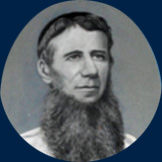 Mgr.Godelle
Mgr.Godelle
Marriage Legislation
There were a number of problems, particularly in the mixed marriages. In 1864 a decree was passed to the effect that the ministers of Christian Religion in British India had the rank of government officers regarding the celebration of marriages. Thus, marriages canonically contracted in the Catholic Church were held as valid by the government. The Parish Priests had only to send quarterly returns of marriages to the registrar of the government. This pleased everybody. Some articles of the law were against the Catholic rules such as concerning the Pauline privilege. The British government showed its good-will by exempting Catholics from paragraphs such as going against the rites, ceremonies and customs of the Roman Catholic Church. Hence the law was again amended in 1872.
Death of Mgr.Godelle
In 1867, all the Bishops of the world were invited to Rome to solemnize the 18th century of the martyrdom of saints Peter and Paul and also to attend at the same day the canonization of 26 Japanese martyrs.
Mgr.Godelle, accompanied by Mgr.Charbonnaux, went to Rome. At the end of the celebrations they both met the Holy Father in private and started their return journey. Meanwhile Mgr.Godelle fell ill and he was taken by Mgr.Charbonnaux to Chambery, where he was admitted in the general hospital, since Mgr.Godelle refused to seek hospitality from the Archbishop of Chambery on account of his austerity and simplicity. He requested Mgr.Charbonnaux to proceed to India while he remained alone in the hospital, in the company of a missionary from China. He received the last sacraments in the presence of the Metropolitan Chapter and expired on the same day on 15th July 1867. He was buried in the graveyard of Chambery and a monument in the Cathedral was erected by public subscription.
On 14th August 1867, a solemn service was held for him at Pondicherry which was attended by all the members of the government and at which military honours were rendered.
 Bishop Laouenan : (1868-1892)
Bishop Laouenan : (1868-1892) 
Mgr.Godelle died without any Co-Adjutor. The choice fell upon Fr.Laouenan, who wrote immediately to Rome expressing his unwillingness to accept the episcopate. But Pope Pius IX, however, appointed him as Bishop of Flaviopolis and Apostolic Vicar of Pondicherry in 1868. He received the Episcopal consecration from Mgr.Charbonnaux on 11th October 1868 in the Cathedral of Pondicherry with all civil and ecclesiastical honours.
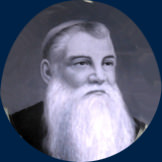 Mgr.Laouenan
Mgr.Laouenan
First Acts of Administration
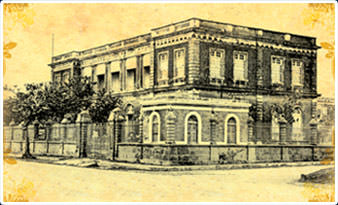 Marie Pondicherry
Marie Pondicherry
Mgr.Laouenan was only 46 years old when he became Bishop. He came to India in 1846. He was successively Professor and Principal of the Colonial College (presently LyceFrancais), Parish Priest at Kumbakonam, assessor during the Apostolic visit of India by Mgr.Bonnand and Superior of the Major Seminary of Pondicherry. He was therefore popular among both Indians and Europeans and was on friendly terms with the Members of the government of Pondicherry.
In 1880, the French law on marriages was extended to French India. According to this law, the Indians who had become French nationals had to undergo a civil marriage at the Municipal Hall before the Church marriage. Besides, rather curiously, all the Christians were subjected to this civil marriage, as if they were all French citizens.
Using the notes and documents of his predecessors Msgr.Laouenan wrote in 1874, the “Statutes of the Vicariate of Pondicherry”. In 1879 this was completely revised and brought up-to-date and became known as the “Directory of the Mission” This book gives all directives concerning the duties of the missionaries and their attitudes towards the customs of the country.
1st September 1886
The old proposal of Mgr.Bonnand and Mgr.Luquet was taken up to establish the hierarchy in 1886.Eight Archbishoprics and seventeen bishoprics and one Apostolic Prefecture in Central Bengal were to be established. Pope Leo XIII officially established the Hierarchy on 1st September 1886 with the issuance of the Bull, Humanae Salutis On 10th March 1887, the Pope Confirmed the agreement of 1st September 1886 with regard to the Apostolic Prefecture of Pondicherry.
Fr.Gandy was elected and ordained as Bishop of Tricala at Pondicherry on September 9, 1883. In 1891 his health suffered very much and he had several strokes of cerebral congestion. He went to France hoping for a cure, but he died there on September 29, 1892 at the Sanatorium of Montbeton.
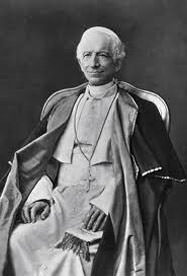
 Archbishop Gandy : (1892 – 1909)
Archbishop Gandy : (1892 – 1909) 
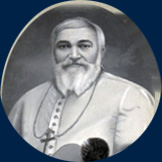 Mgr.Gandy
Mgr.Gandy
Mgr.Gandy was the coadjutor of Mgr.Laouenan since 1883. He succeeded automatically Mgr.Laouenan when he died. He knew the diocese more than any other bishop. He used to visit every village of every parish. In the absence of Mgr.Laonenan while he was in Europe, between 1884 to 1886, he managed the diocese very well. In 1889 he was given the title of Archbishop of Claudionopolis. In 1892 he became officially the Archbishop of Pondicherry.
Situation of the Mission in 1892
Pondicherry, now an Archdiocese, had Mysore, Coimbatore and also Malaca – Singapore as its suffragan dioceses.
Thanks to the influence of the devotion to Sacred Heart of Jesus at Montmartre in Paris, Mgr.Gandy consecrated the Archdiocese of Pondicherry to the Sacred Heart of Jesus in June 1895. He planned to have a new large Church of Sacred Heart constructed in Pondicherry. On the 27th January 1908 Mgr.Gandy celebrated solemn mass in the new sacred heart church built by Fr.Telesphore Welter MEP.
Mgr.Gandy proposed to have only one Major Seminary for the entire Ecclesiastical Province. This idea was accepted by all and in 1897 the Major Seminary of Pondicherry became the Provincial Major Seminary.
Mgr.Gandy was becoming weaker day by day and wanted a successor. He went to Yercaud for some rest. There was no improvement either. He died there on 25th March 1909 without any coadjutor.
 Archbishop Morel (1909-1930)
Archbishop Morel (1909-1930) 
In 1908, Mgr.Gandy requested Rome to give him a coadjutor. He died before getting a definite answer. Six months after his death Rome appointed a successor in the person of Mgr.Morel.
Fr.Morel after his arrival at Pondicherry was appointed Professor of Science at the Colonial College. He then became the Parish Priest of Tennur for a while. He was recalled to become Professor at St.Joseph’s High School, Cuddalore. Intellectually bright, he was a famous mathematician. In 1905 he succeeded Fr.Faure as Rector of the Major Seminary. He taught Philosophy. He was also the Vicar General. He remained in the Major seminary till his election to the episcopate in 1909.
On 21st September 1909 he was consecrated Archbishop by Mgr.Bottero in the presence of the Bishops of Mysore, Coimbatore, Madras-Mylapore, Rangoon and Mandalay.
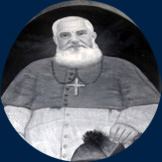 Mgr.Morel
Mgr.Morel
Situation in 1909
In 1909 there were 77 missionaries and 22 Indian priests. Between 1909 to 1930, 29 missionaries died 2 left the mission and only 16 new ones arrived from Paris. Among the 22 Indian Priests, 12 died. But there were only 23 new ordinations.
In 1914 the First World war broke out. In January 1915, 14 priests and one brother had to join the army . And in August again two other priests and another brother were requisitioned to the army.
Mgr.Morel himself set an example by taking charge of the parish of Villupuram during the period of the war!
Many parishes were regrouped to be under a single Parish Priest. Assistant priests were also given charge of the parishes.
At the Cathedral, the four year strike of the caste people made a dent in the parish life. Fr.Combes started a 10 day “mission” and brought back the parish to its normal life again.
Fr.Gayet was appointed Rector of the Provincial Major Seminary and he remained at its helm till 1945 even after its transfer from Pondicherry to Bangalore under the title of St.Peter’s Seminary in 1934. During this period all in all 68 Indian priests were ordained for all the dioceses of the province of Pondicherry.
With the idea to centralise the activities, Mgr.Morel started the deanery system in 1928. Eleven such deaneries or Vicariates were created with a Vicar Forane at the head of each.
Education
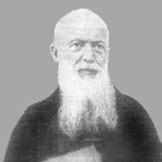
Petit Seminaire under Fr.Escande enjoyed an era of remarkable prosperity. Fr.Escande himself was known as the “Apostle of Petit Seminaire”.
In Cuddalore, St.Joseph’s College was affected by the new syllabus of the Madras University. Two degree courses had to be cancelled. Hence from 1911, it became only a High School and ceased to be a College.
An extraordinary progress was made with regard to the Elementary Schools by Rev.Fr.Thomas Gavan-Duffy. He created a diocesan organization, named “Comite’ d’ Education” after his appointment in 1918 as the Inspector of the Mission Schools.
In 1921, Fr.Gavan Duffy started a Training School at Tindivanam with 22 students. St.Anne’s Primary school became a Middle School under the effective direction of Bro.Claudien (Montfort Brother).
More than schools and teachers, Fr.Gavan Duffy was interested in the training of the Catechists. The training given by Fr.Gavan Duffy would prepare Teachers or Catechists with good formation in Secular and religious studies. The best teachers after a few years of teaching would be raised to the grade of Catechists.
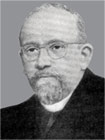
Resignation of Archbishop Morel
Archbishop Morel, 68 years old, requested Rome to accept his resignation, which was accepted. Fr.Colas was appointed and was consecrated by Archbishop Morel on 29th September 1930. Retiring to Yercaud, Mgr.Morel did what he could do for about ten years. In 1940 he went to St.Martha’s Hospital, Bangalore and he died there in 1948, eighteen years after his resignation.
 Archbishop A.S.Colas (1930-1955)
Archbishop A.S.Colas (1930-1955) 
Mgr.A.S.Colas was consecrated on 29th September 1930 by Archbishop Morel, assisted by Mgr.Roy, Bishop of Coimbatore and Mgr.Prunier of Salem.
In 1932 a new Minor Seminary was opened in Cuddalore with Fr.Campuzan as its Rector. In 1934 at the wish of Rome, which generously contributed for the buildings, the major Seminary of Pondicherry was shifted to Bangalore. It become a Regional Seminary under the new name of St.Peter’s Seminary. The MEP Fathers took charge of the seminary with Fr.Gayet as the Rector.
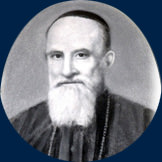 Mgr.A.S.Colas
Mgr.A.S.Colas
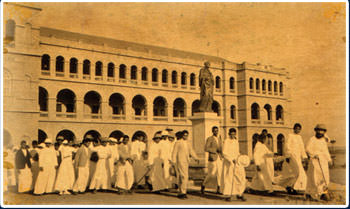 St.Peter’s Seminary, Bangalore
St.Peter’s Seminary, Bangalore
In 1948, Fr.Mark Gopu was ordained Auxiliary Bishop to Archbishop Colas. When Rome transferred him to the Archdiocese of Hyderabad in January 1953, Fr.Ambrose of Coimbatore, who was a Professor at St.Peter’s Seminary, Bangalore, was nominated Auxiliary Bishop of Pondicherry . He was later made into coadjutor Bishop.
When Archbishop Colas resigned Mgr.Ambrose became the first Indian Archbishop of Pondicherry and Cuddalore.
The New name
As the Archdiocese of Pondicherry extended over the Pondicherry Union Territory and the South Arcot District of Tamilnadu State, it was given a new title or name by Rome: “Archdiocese of Pondicherry and Cuddalore” on 07-08-1953.
 Archbishop R.Ambrose (1955-1973)
Archbishop R.Ambrose (1955-1973) 
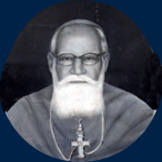 Archbishop Ambrose
Archbishop Ambrose
He became Archbishop in 1955. As Auxiliary Bishop he fully cooperated with Archbishop Colas in the removal of caste distinctions in the Churches. He maintained discipline in the Archdiocese and, though firm, he had a great concern for the priests.He retired on 15-06-1973, and passed away on 24-11-1999.
 Archbishop V.S.Selvanather (1973-1992)
Archbishop V.S.Selvanather (1973-1992) 
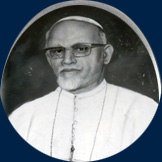 Archbishop V.S. Selvanather
Archbishop V.S. Selvanather
Bishop V.S.Selvanather was transferred from the see of Salem and appointed Archbishop of Pondicherry and Cuddalore in 1973. He had a great concern for the poor. It was he who was responsible for the establishment of Pondicherry Multipurpose Social Service Society (PMSSS) and South Arcot Multipurpose Social Service Society (SAMSSS) and credit societies in various parishes.
He encouraged promotion of laity and formation of good family life. Regarding higher education, he helped to start St.Joseph’s College of Arts and Science and St.John’s College Seminary at Cuddalore to help the Seminarians of the Province of Pondicherry and the Pope John Paul II College of Education. He retired on 24-06-1992 and passed away on 14-10-1993.
 Archbishop Michael Augustine (1992-2004)
Archbishop Michael Augustine (1992-2004) 
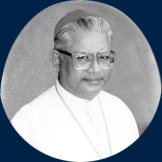 Archbishop Michael Augustine
Archbishop Michael Augustine
The announcement of Most Rev.Dr. Michael Augustine as the Archbishop of Pondicherry and Cuddalore came on 25-03-1992 and was installed as the Archbishop on 25-06-1992. During his 12 yers of episcopacy the Archdiocese saw newer heights. He laid foundations for 2 new vicariates, 14 new parishes and invited 13 new religious congregations to work in the Archdiocese.
According to 2001 Census, the total population of Cuddalore and Villupuram Districts is 52,24,454 and the total population of Pondicherry & Karaikal Districts is 9,05,644. Thus the total population of this area is 61,30,098. Among them Christians are 2,99,667. He was true to the dignity of his office and always felt happy and cheerful to serve his flock. On 05-07-2004 the Holy Father accepted his resignation and appointed Most Rev. Dr Antony Anandarayar the Bishop of Ottacamund as the succeeding Archbishop of Pondicherry and Cuddalore.
 Archbishop A. Anandarayar (2004 -2021)
Archbishop A. Anandarayar (2004 -2021) 
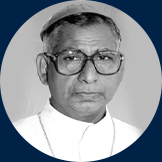 Archbishop A. Anandarayar
Archbishop A. Anandarayar
ON 06-05-2010 THE ARCHBISHOP, MOST. REV. DR. A. ANTONY ANANDARAYAR APPOINTED HIM AS THE VICAR GENERAL OF OUR ARCHDIOCESE. Apart from the works of the Vicar General our very Rev. Monsignor also looks after the catechists of our Archdiocese. When evangelization and pastoral needs predominate, the main concern of the Archdiocese is to employ the necessary personnel to impart the Word of God. A catechist in our tradition is like a right hand helping us in our evangelization and pastoral work. At present we have both trained and untrained catechists who assist the priests of our Archdiocese in carrying out their pastoral responsibility effectively.
 The chronological tree of our former prelates
The chronological tree of our former prelates 
Superiors of the Carnatic Mission
- Most Rev.Pierre Brigot(1776-1791)
- Most Rev.Champenois(1791-1810)
- Most Rev.Hebert(1810-1836)
Vicars Apostolic
- Most Rev.Bonnand (1836-1861)
- Most Rev.Godelle (1861-1867)
- Most Rev.Laouenan (1868-1886)
Archbishops
- Most Rev.Laouenan (1886-1892)
- Most Rev.Joseph Gandhi (1892-1909)
- Most Rev.Morel (1909-1929)
- Most Rev.A.S.Colas (1930-1955)
- Most Rev.Rayappan Ambrose (1955-1973)
- Most Rev.Venmani S. Selvanathar (1973-1992)
- Most Rev.S.Michael Augustine (1992-2004)
Auxiliary Bishops
- Most Rev.Mark Gopu (1948-1953)
- Most Rev.R.Ambrose (1953-1954)
Coadjutor Bishops
- Most Rev.Champenois(1786-1791)
- Most Rev.Bonnand (1833-1836)
- Most Rev.Luquet (Consecrated in 1845 but did not return to Pondicherry)
- Most Rev.Godelle (1857-1861)
- Most Rev.Joseph Gandy(1883-1889)
- Most Rev.R.Ambrose (1954-1955)
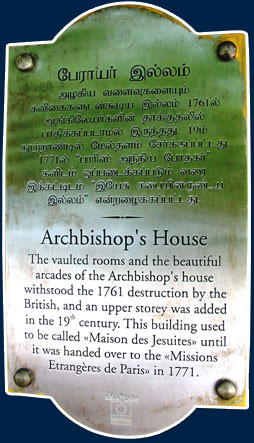
An Heritage Site Plaque on Archbishop’s
House Pondicherry
 Contribution of the Archdiocese to Holy Mother the Church
Contribution of the Archdiocese to Holy Mother the Church 
HIS EMINENCE SIMON CARDINAL LOURDUSAMY
Date of Birth : February 05, 1924
Place : Kalleri , Tamil Nadu, India.
Secular Studies : St. Anne's High School, Tindivanam(1937-39)
St. Joseph’s Higher Secondary School, Cuddalore. (1939-1945)
Loyola College, Madras. (1952-1953)
Ecclesiastical Studies and Years of Formation
St.Agnes’ Minor Seminary (1939-1945)St. Peter’s Seminary, Bangalore (1946-1951)
Ordained On : 21st December 1951 at Tindivanam
Credentials :
Doctorate in Canon Law from the Pontifical Urbaniana University in Rome (1953-1956).
DESIGNATIONS:
- Archdiocesan Archivist (1952)
- Assistant, Atthipakkam Parish (8.3.1952 to 15-04-1952)
- Secretary to the Archbishop (May 1952 to June 1952)
- Chancellor, Secretary to the Archbishop, editor of Sarvaviabi (The Catholic Weekly Magazine run by the Archdiocese) and the Choir Master of the Cathedral (03-12-1956 to 18-07-1962).
- Nominated Bishop Auxiliary to the Archbishop of Bangalore (02-07-1962)
- Received his Episcopal consecration on the following August 22, 1962 from Archbishop Rayappan Ambrose, with Bishops Rajarethinam Sundaram and Daniel Arulswamy serving as co-consecrators in Pondicherry.
- Attended the Second Vatican Council (1962-1965).
- On November 9, 1964, he was made the Coadjutor Archbishop of Bangalore, and then succeeded Thomas Pothacamury as the Archbishop of Bangalore on January 11, 1968.
- 05-03-1971 appointed Joint Secretary to the Congregation of Propagation of Faith.
- On February 26, 1973 appointed as the Secretary of the Evangelization of Peoples and Vice Chancellor of the Urbaniana University.
- His Holiness Pope John Paul II raised Archbishop Lourdusamy to the state of a Cardinal Deacon in the consistory of May 25, 1985.
- October 30, 1985 to May 24, 1991 appointed as the Prefect of the Congregation for the Oriental Churches.
- on April 5, 1993, and served as a special papal legate at the funeral of Mother Teresa on September 13, 1997.
- On April 5, 1993 was appointed protodeacon. He chose to become a Cardinal Priest on January 29, 1996.
- On 21.12.2011 the Diamond Jubilee of the Sacradotal ordination of the Cardinal was celebrated in a grand manner at the Cathedral in Pondicherry.
- Died in Rome on 02.06.2014, at 05.05 a.m.
- Funeral Mass and Burial on 09.06.2014 at 10.00 a.m. at the Immaculate Conception Cathedral, Pondicherry
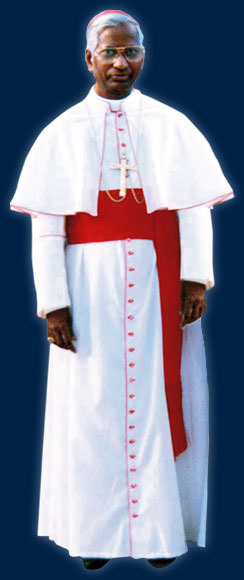
MOST REV. DR. UBAGARASAMY
BERNADETH
Bishop of Coimbatore 1940

MOST REV. DR. JOSEPH THUMMA
Bishop of Vijayawada 1970
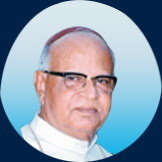
MOST REV. DR. MARK GOPU
Auxiliary Bishop of Pondicherry 1948
Archbishop of Hyderabad 1953
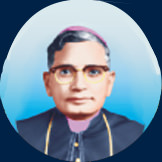
MOST REV. DR. MICHAEL
DURAISAMY
Bishop of Salem 1974
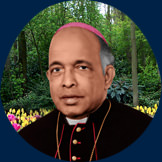
MOST REV.DR. MICHAEL AUGUSTINE
Auxiliary Bishop of Madras 1978
Bishop of Vellore 1981
Archbishop of Pondicherry 1992

MOST REV. DR. ANTONY ANANDARAYAR
Bishop of Ootacamund 1997
Archbishop of Pondicherry 2004
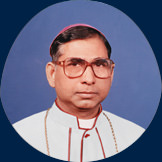
MOST REV.DR. YVON
AMBROISE
Bishop of TUTOCORIN 2005
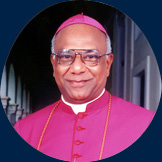
RT REV DR. A. PETER ABIR BISHOP OF SULTHANPET
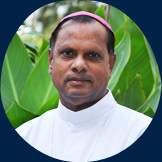
NATIVES OF THE ARCHDIOCESE OF PONDICHERRY
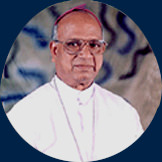
MOST REV. DR. A.M. CHINNAPPA, SDB
Archbishop of Madras – Mylapore
- Born: 23rd July 1937
- Native of Ayandur Parish
- Ordained Priest: 16th December 1972 for the Congregation of Salesians of Don Bosco
- Appointed Bishop of Vellore: 25th January 1994
- Appointed as Archbishop of Madras - Mylapore : 1st April 2005
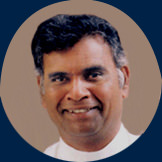
RT REV. DR. A. NEETHINATHAN
Bishop of Chingleput
- Born: 03rd July 1955
- Native of Kakkanur Parish
- Ordained Priest: 09th May 1987 for the Archdiocese of Madras- Mylapore
- Appointed Bishop of Chingleput: 19th July 2002
- Consecration: 29th September 2002
- The Pondicherry Mission in 1700 A.D
- The Presence of the MEP
- Mgr.Pierre Brigot (1776-1791)
- Mgr Champanois (1786-1810)
- Mgr.Hebert (1810-1836)
- Mgr.Bonnand (1836-1846)
- Mgr.Godelle (1861-1867)
- Bishop Laouenan (1868-1892)
- Archbishop Gandy (1892 1909)
- Archbishop Morel (1909-1930)
- Archbishop A.S.Colas (1930-1955)
- Archbishop R.Ambrose (1955-1973)
- Archbishop V.S.Selvanather (1973-1992)
- Archbishop Michael Augustine (1992-2004)
- Archbishop A. Anandarayar (2004-2021)
- The chronological Tree of our Former Prelates
- Contribution of our Archdiocese to Holy Mother the Church




